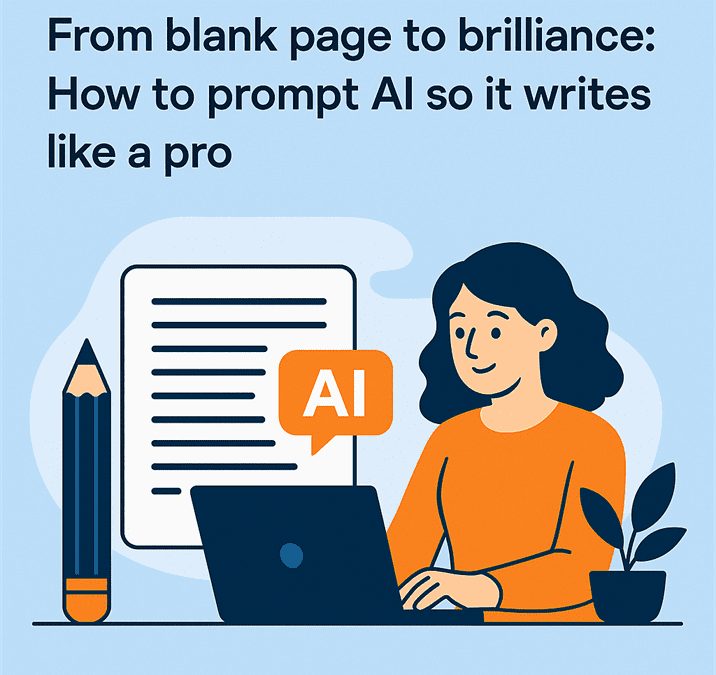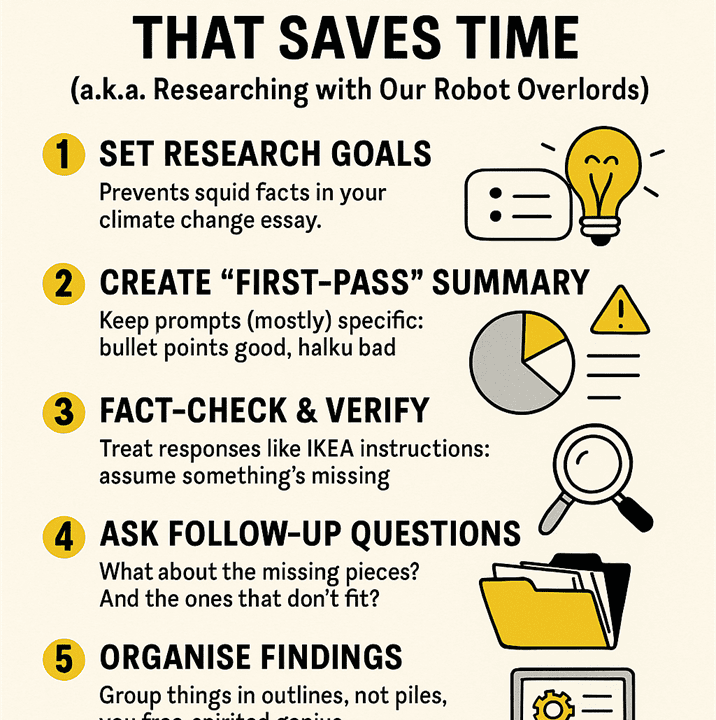From blank page to brilliance: How to prompt AI so it writes like a pro

So, you’ve decided to summon the magical powers of AI to help you write.
Congratulations! But before you get too excited, let me drop some truth: AI output is only as good as the input.
You can’t just throw a random string of words at it and expect it to create Shakespeare.
It’s more like a pizza dough. The better the ingredients (prompt), the better the final result (content).
But don’t worry. I’m here to help you turn your AI prompts into literary masterpieces, or at least into something you won’t be embarrassed to share.
Ready?
Let’s dive into the world of AI content prompts, where precision is your best friend, and vague requests lead to disaster.
Understanding AI’s context hunger
Before we dive into prompt engineering, let’s talk about AI’s insatiable need for context.
You know how you can’t write a decent email to your boss without knowing the why and the who behind it?
Same thing with AI.
You’ve got to feed it information, or it’ll just make up something that’s likely only half-right (and let’s be honest, AI has a weird obsession with “robots” and “spaceships” for no apparent reason).
Think of AI like a toddler in a highchair.
Give it direction, and it’ll make something halfway decent.
Leave it to its own devices with no guidance, expect mashed potatoes on the walls and half-eaten peas (metaphorically speaking).
So, before you type out your prompt, ask yourself: What’s the goal here? Who’s my audience? How should the tone feel?
Structuring an effective brief: Goal, audience, tone, SEO targets
Now we’ve identified the context hunger problem, let’s tackle how to actually feed the AI.
We’re talking about structuring a brief that’s clear, concise, and full of everything the AI needs to succeed.
Think of this like a recipe for a 5-star dinner. If you miss an ingredient, the whole thing could fall flat.
Here’s the basic breakdown:
- Goal: What are we trying to achieve? Are we informing, entertaining, persuading? Without this, your AI could write an entire novella about why you shouldn’t buy pineapple on pizza, when all you wanted was a quick blog post on “10 Best Pizza Toppings.”
- Audience: Who are we speaking to? Is this for college students looking for an essay, or a business owner looking for conversion copy? This helps tailor the language and complexity.
- Tone: You wouldn’t talk to your grandma the same way you’d talk to your best friend (unless your grandma is super chill, in which case, teach me your ways). Tell AI if the tone should be formal, conversational, playful, or even sarcastic (yes, it can pull that off, too).
- SEO targets: If you’re in the blogging game (and let’s face it, you probably are), you need to let the AI know which keywords you want to hit. Don’t assume it’ll just sprinkle SEO magic dust over your writing. You’ve got to be clear about which terms need a shout-out.
So, instead of just saying, “Write a blog post about pizza toppings,” give your AI something like this:
Goal: Create a blog post to help readers discover new pizza topping ideas.
Audience: Young adults aged 18-30, pizza lovers, foodies.
Tone: Casual, friendly, and a bit humorous.
SEO Target: Include “best pizza toppings” and “creative pizza topping ideas.”
See? Much clearer. AI’s going to thank you for it.
Examples of bad vs good prompts
Okay, let’s spice things up with a quick showdown: bad vs good AI prompts.
Bad Brief:
“Write a blog post about pizza.”
This is the AI equivalent of sending your friend a text saying, “Bring food.” Okay, but what kind of food? Do you want extra cheese? Gluten-free? Pizzas in space?
Good Brief:
“Write a blog post about 10 unique pizza toppings for adventurous eaters. Focus on flavours that are bold, unexpected, and pair well with classic toppings. Keep the tone light and fun and use SEO keywords: ‘best pizza toppings’ and ‘creative pizza topping ideas.’ Target audience: young adults, ages 18-30, who love experimenting with food.”
Boom. Now we’ve got some magic happening.
Checklist: The AI-ready content prompt template
Ready to take notes?
Here’s a handy checklist for crafting AI content prompts that make AI feel like it’s working with a pro (because it is).
- State the goal: What do you want to achieve? (E.g., educate, entertain, convert)
- Define the audience: Who are you speaking to? (E.g., teenagers, tech experts, mums)
- Set the tone: How should the content sound? (E.g., formal, friendly, humorous)
- Specify SEO targets: What keywords should be included?
- Be detailed, but not too detailed: Give enough direction without stifling creativity. AI is a tool, not a mind reader.
Once you’ve filled out these questions, you’ve got yourself an AI-ready content prompt.
Congratulations, you’re now in the writer’s club.
How to prompt AI so it writes like a pro
And there you have it.
The secret to prompting AI like a pro is simple. Be specific, clear, and give it all the context it needs to thrive.
Follow the formula, and you’ll be amazed at how quickly your AI content transforms from meh to magnificent.
Now go forth, prompt like a wizard, and let the words flow, your blank page is officially under attack!
If you need a onceover from a professional before you hit Publish, get in touch.
Prompting AI frequently asked questions
Why is my AI-generated content not very good?
If your AI content is coming out all over the place or just doesn’t hit the mark, it’s likely because the input (your prompt) wasn’t specific enough. AI is like a helpful but somewhat clueless intern. If you just give it a vague direction, it might give you something that’s too broad or doesn’t align with your goals.
To make AI work for you, you need to provide clear instructions: state the goal (inform, entertain, convert), define the audience (age, interests), set the tone (formal, casual, sarcastic), and if you’re targeting SEO, include your keywords. A more specific prompt gives the AI the context it needs to create content that’s closer to what you envision.
Can I use AI to write my blog posts for me?
Yes, absolutely! AI can be an excellent assistant for writing blog posts but think of it as your co-writer, not a ghostwriter. You still need to provide structure, direction, and your personal flair. You’ll also need to edit afterwards.
AI can help you get the ball rolling, generate ideas, and even write full drafts, but you’ll likely need to step in to fine-tune the tone, check for factual accuracy, and ensure it fits your brand voice. So, while AI can save you time and help with the writing process, your human touch will make sure the content stands out.
How specific should I be when crafting an AI prompt?
The more specific you can be, the better. Think of it like giving a recipe. If you tell the AI to “write a blog post about pizza,” that’s like saying, “Make me dinner.” But if you say, “Write a blog post about 10 unique pizza toppings for adventurous eaters, with a fun and casual tone, including SEO keywords like ‘best pizza toppings’ and ‘creative pizza topping ideas,’” that’s giving the AI a full meal plan to work with.
Being detailed doesn’t mean you’re stifling creativity. It’s just giving the AI the ingredients it needs to create something relevant and effective.
Is there such a thing as a “perfect” AI prompt?
Unfortunately, there’s no one-size-fits-all perfect prompt. The key to a successful AI prompt is trial and error, as well as refining the process over time. AI is a tool, and like any tool, you need to figure out the best way to use it for your specific needs.
That said, there are definitely common strategies for creating high-quality prompts, such as being clear, concise, and goal oriented. The more you practice prompting, the more you’ll develop a feel for what works best for your content.
Can AI understand nuances like tone or style?
AI is pretty good at mimicking different tones and styles, but you need to explicitly instruct it. If you want your blog post to sound funny, make sure you tell the AI that. If you want it to be formal, state that upfront too.
AI’s ability to handle tone and style is growing, but it still requires clear guidance. The more context you provide, the better it can adapt to your desired voice.
How do I know if my AI-generated content is original?
AI does a great job of generating new content based on prompts, but it’s always wise to check for plagiarism, especially if you’ve used the AI to rewrite or summarize existing content.
You can use tools like Copyscape or Turnitin to verify the originality of the content. Even though AI can generate unique sentences, it’s good practice to check that the output doesn’t unintentionally resemble any source material too closely.
Can AI generate content for specific industries or niches?
Yes, absolutely! AI can be trained or prompted to generate content for almost any industry or niche, whether it’s technology, fashion, or pizza toppings (yes, again, pizza!).
The more you specify the industry or niche in your prompt, the more relevant and tailored the AI’s output will be. For instance, if you want a blog post about SEO for eCommerce websites, your prompt should mention that. This helps the AI focus on the terminology, trends, and tone that match the industry’s needs.
Can I rely entirely on AI for my content?
While AI can speed up content creation and help you brainstorm ideas, it’s not a replacement for human creativity and expertise. Content that resonates with readers often needs that personal touch, your insights, experiences, and nuanced understanding of your audience.
AI is a powerful tool to assist with the technical aspects of content creation (like generating ideas, structuring posts, or tackling writer’s block), but you should always put your personal spin on it. After all, no matter how advanced AI gets, it still can’t replace the unique voice and authenticity that humans bring to the table.
How can I make my AI-generated content sound more human?
The trick to making AI content sound more human is by adding your own voice. Once AI generates the content, read it through and adjust the tone or add personal anecdotes, jokes, or references to make it more relatable.
AI might have the vocabulary, but it doesn’t have the lived experiences that make your content stand out. So, feel free to inject some personality into the final draft to make sure it sounds like you!



